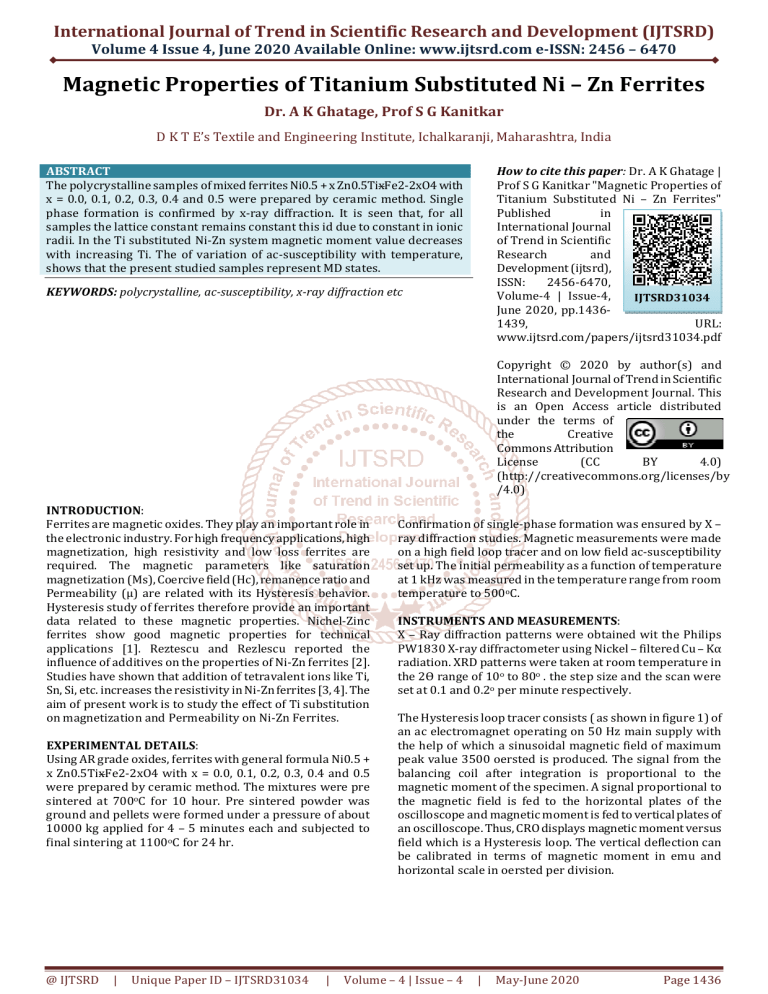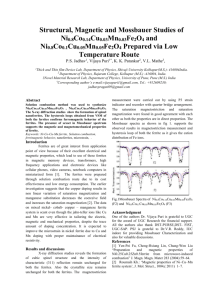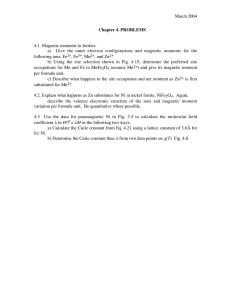
International Journal of Trend in Scientific Research and Development (IJTSRD) Volume 4 Issue 4, June 2020 Available Online: www.ijtsrd.com e-ISSN: 2456 – 6470 Magnetic Properties of Titanium Substituted Ni – Zn Ferrites Dr. A K Ghatage, Prof S G Kanitkar D K T E’s Textile and Engineering Institute, Ichalkaranji, Maharashtra, India How to cite this paper: Dr. A K Ghatage | Prof S G Kanitkar "Magnetic Properties of Titanium Substituted Ni – Zn Ferrites" Published in International Journal of Trend in Scientific Research and Development (ijtsrd), ISSN: 2456-6470, Volume-4 | Issue-4, IJTSRD31034 June 2020, pp.14361439, URL: www.ijtsrd.com/papers/ijtsrd31034.pdf ABSTRACT The polycrystalline samples of mixed ferrites Ni0.5 + x Zn0.5TixFe2-2xO4 with x = 0.0, 0.1, 0.2, 0.3, 0.4 and 0.5 were prepared by ceramic method. Single phase formation is confirmed by x-ray diffraction. It is seen that, for all samples the lattice constant remains constant this id due to constant in ionic radii. In the Ti substituted Ni-Zn system magnetic moment value decreases with increasing Ti. The of variation of ac-susceptibility with temperature, shows that the present studied samples represent MD states. KEYWORDS: polycrystalline, ac-susceptibility, x-ray diffraction etc Copyright © 2020 by author(s) and International Journal of Trend in Scientific Research and Development Journal. This is an Open Access article distributed under the terms of the Creative Commons Attribution License (CC BY 4.0) (http://creativecommons.org/licenses/by /4.0) INTRODUCTION: Ferrites are magnetic oxides. They play an important role in the electronic industry. For high frequency applications, high magnetization, high resistivity and low loss ferrites are required. The magnetic parameters like saturation magnetization (Ms), Coercive field (Hc), remanence ratio and Permeability (μ) are related with its Hysteresis behavior. Hysteresis study of ferrites therefore provide an important data related to these magnetic properties. Nichel-Zinc ferrites show good magnetic properties for technical applications [1]. Reztescu and Rezlescu reported the influence of additives on the properties of Ni-Zn ferrites [2]. Studies have shown that addition of tetravalent ions like Ti, Sn, Si, etc. increases the resistivity in Ni-Zn ferrites [3, 4]. The aim of present work is to study the effect of Ti substitution on magnetization and Permeability on Ni-Zn Ferrites. EXPERIMENTAL DETAILS: Using AR grade oxides, ferrites with general formula Ni0.5 + x Zn0.5TixFe2-2xO4 with x = 0.0, 0.1, 0.2, 0.3, 0.4 and 0.5 were prepared by ceramic method. The mixtures were pre sintered at 700oC for 10 hour. Pre sintered powder was ground and pellets were formed under a pressure of about 10000 kg applied for 4 – 5 minutes each and subjected to final sintering at 1100oC for 24 hr. @ IJTSRD | Unique Paper ID – IJTSRD31034 | Confirmation of single-phase formation was ensured by X – ray diffraction studies. Magnetic measurements were made on a high field loop tracer and on low field ac-susceptibility set up. The initial permeability as a function of temperature at 1 kHz was measured in the temperature range from room temperature to 500oC. INSTRUMENTS AND MEASUREMENTS: X – Ray diffraction patterns were obtained wit the Philips PW1830 X-ray diffractometer using Nickel – filtered Cu – Kα radiation. XRD patterns were taken at room temperature in the 2ϴ range of 10o to 80o . the step size and the scan were set at 0.1 and 0.2o per minute respectively. The Hysteresis loop tracer consists ( as shown in figure 1) of an ac electromagnet operating on 50 Hz main supply with the help of which a sinusoidal magnetic field of maximum peak value 3500 oersted is produced. The signal from the balancing coil after integration is proportional to the magnetic moment of the specimen. A signal proportional to the magnetic field is fed to the horizontal plates of the oscilloscope and magnetic moment is fed to vertical plates of an oscilloscope. Thus, CRO displays magnetic moment versus field which is a Hysteresis loop. The vertical deflection can be calibrated in terms of magnetic moment in emu and horizontal scale in oersted per division. Volume – 4 | Issue – 4 | May-June 2020 Page 1436 International Journal of Trend in Scientific Research and Development (IJTSRD) @ www.ijtsrd.com eISSN: 2456-6470 A specimen kept at the center of a balanced double coil which itself is at the center of Helmoltz coil system producing an alternating magnetic field behaves like an alternating dipole and induces a differential emf in the double coil. The current to the Helmoltz coil is supplied by a oscillator and a high quality power amplifier. The signal induced in the double coil, which is proportional to the rate of change of magnetic moment of the specimen is amplified and read out on a digital voltmeter. The sample was enclosed in a glass jacket containing the platinum – rhodium thermocouple to sense the temperature. The measurements were taken from room temperature up to 500oC. the magnetic moments were observed for different constant temperature. RESULTS AND DISCUSSION: X -Ray Diffraction: In an x-ray diffraction pattern of any spinel ferrite the peak (311) is very prominent and can be identified easily. The corresponding values of 2ϴ is noted from the diffraction pattern. Using the values of 2ϴ, (hkl) and λ and using the equations 2d Sinϴ = nλ And Lattice parameter ‘a’ can be calculated and using these a values ‘d’ values can be calculated. In case of the system Ni0.5 + x Zn0.5TixFe2-2xO4 from table.1 it is seen that, for all samples the lattice constant remains constant. Here in this case the two ions of Fe2+ are substituted one by Ni2+ and one by Ti4+ ions. The ionic radii of all these ions are nearly same (0.67 Ao). Therefore, the constancy in lattice constant may be because of constant ionic radii. Magnetization: The values of saturation magnetization and magnetic moment at room temperature are noted in table.2. in the Ti substituted Ni-Zn system magnetic moment value decreases with increasing Ti. Similar results are observed in many ferrites containing Zinc and tetravalent ions. The variation of magnetization in ferrites can be understood in terms of cation distribution. There are three kind of exchange interaction exists in Spinel, namely A-A, B-B and A-B interaction. Out of these A-B interactions is more effective and stronger. The net magnetic moment of lattice is given by the vector sum of the magnetic moment on A and B sublattices. The magnetization behavior and cation distribution in ferrites is explained by Verway and Hillman, Gorter, Goodenough and Locb Dunitz and Orgel and Miller [5, 6, 7, 8,9,]. Miller has observed that, tetravalent ions such as Ti would occupy B site. Therefore, by considering the site preference energies and calculated cation distribution for Ni-Zn ferrite is suggested as below. [Zn0.5Fe0.5-yTiy] [Ni0.5+xFe1.5-2x-yTix-y] AC-Susceptibility The variation Normalized ac-susceptibility with Temperature is as shown in figure.2 and Curie temperature is determined from these plots and noted in table.2. from the nature of the plots following observations are made @ IJTSRD | Unique Paper ID – IJTSRD31034 | Volume – 4 | Issue – 4 | May-June 2020 Page 1437 International Journal of Trend in Scientific Research and Development (IJTSRD) @ www.ijtsrd.com eISSN: 2456-6470 X-ray diffraction pattern of Ni0.5 Zn0.5Fe2O4 1. 2. 3. 4. Ac-susceptibility remains almost constant in all the samples until temperature reaches near to curie temperature. Ac-susceptibility drops suddenly to zero at curie temperature. No peaks in ac-susceptibility plot is observed in the range of temperature studied. A tailing effect is observed for higher contents of substitution. A polycrystalline ferrite may consist of three types of domain states such as MD (multi domain) SD (single domain) and SP (super paramagnetic). It has been shown that the susceptibility for MD samples does not change with temperature and drops at curie temperature. For SP samples susceptibility decreases with temperature and becomes zero at curie temperature.in the case of SD particles susceptibility increases and shows a maximum near curie temperature. Based on the above concepts and nature of variation of ac-susceptibility with temperature. It can be concluded that the present studied samples represent MD states. Radhakrishnamurthy et. Al [10] have explored the magnetic behavior of ferrites, from the observations it is concluded that the tailing effect in ac-susceptibility with temperature plot may be due to impurity phases or due to canting effect. In general, the decrease in curie temperature values is observed with increasing concentration of Ti. Curie temperature of ferrites have closely related to number of Fe-O-Fe linkages. In the present case 2Fe is replaced by Ni + Ti which ultimately decreases the number of Fe-O-Fe linkages. In case of nonmagnetic substitutions there is no contribution from A-B interaction in the spinel. Hence curie temperature decreases with increase in Ti. @ IJTSRD | Unique Paper ID – IJTSRD31034 | Volume – 4 | Issue – 4 | May-June 2020 Page 1438 International Journal of Trend in Scientific Research and Development (IJTSRD) @ www.ijtsrd.com eISSN: 2456-6470 Table.1: Physical constants of the system Ni0.5 + x Zn0.5TixFe2-2xO4 Molecular Measured X-ray density Lattice Composition weight gm/mole density (g/cc) (g/cc) parameter Ni0.5 Zn0.5Fe2O4 237.73 4.24 5.342 8.390 Ni0.6 Zn0.5Ti0.1Fe1.8O4 237.22 4.21 5.331 8.392 Ni0.7 Zn0.5Ti0.2Fe1.6O4 236.71 4.16 5.305 8.399 Ni0.8 Zn0.5Ti0.3Fe1.4O4 236.21 4.16 5.332 8.385 Ni0.9 Zn0.5Ti0.4Fe1.2O4 235.69 4.05 5.283 8.399 Ni1.0 Zn0.5Ti0.5Fe1.0O4 235.19 4.04 5.277 8.396 Table.2: Magnetization, magnetic moment and curie temperature for the system Ni0.5 + x Zn0.5TixFe2-2xO4 Composition Magnetization emu/gm Magnetic moment in Bohr magneton Curie Temperature K Ni0.5 Zn0.5Fe2O4 378.21 3.76 620 Ni0.6 Zn0.5Ti0.1Fe1.8O4 357.43 2.42 590 Ni0.7 Zn0.5Ti0.2Fe1.6O4 327.76 1.89 535 Ni0.8 Zn0.5Ti0.3Fe1.4O4 196.19 1.49 523 Ni0.9 Zn0.5Ti0.4Fe1.2O4 162.36 1.02 475 Ni1.0 Zn0.5Ti0.5Fe1.0O4 142.89 0.89 460 Conclusion: These ferrites substituted with Ti exhibit high permeability and multi domain states. obse It is concluded that the tailing effect in ac-susceptibility with temperature plot may be due to impurity phases or due to canting effect. References [1] M. Abe. M. Matsumoto (Eds.), Proc. ISFA. 97) Symp. J. of IUMRS-ICA-97), Mag. Soc. Jpn. 22 Supl. (1998) [2] N Rezlescu, E Rezlescu, Solid State Communications 88(1993) 139 [3] C M Srivastava, M J, Patni (Eds.) Advances in ferrites (Proc. Of ICF-5) 1989, oxford and IBH Publishers, Delhi. India @ IJTSRD | Unique Paper ID – IJTSRD31034 | [4] B V Bhise, S D Lotke, S A Patil. Phys. Stat. Solidi (A) 157(1996)411 [5] Gorter E W Proc. IRE,43(1955) 1945 [6] Verway E J W and Hillman K L J. Chem Phy 15 (1947) 174 [7] Goodenough and Loeb A L Phy. Rev, 98(1957) 318 [8] Dunitz and Orgel L F J. Phys. Chem. Solids 3 (1957) 318 [9] Miller A J Journal of Applied Physics 30 (1959) 248 [10] Radhakrishnamurthy C. , Likhite S D, Deutch A B and Murty G S Phy. Earth and Planet Int, 30(1982) 281 Volume – 4 | Issue – 4 | May-June 2020 Page 1439


